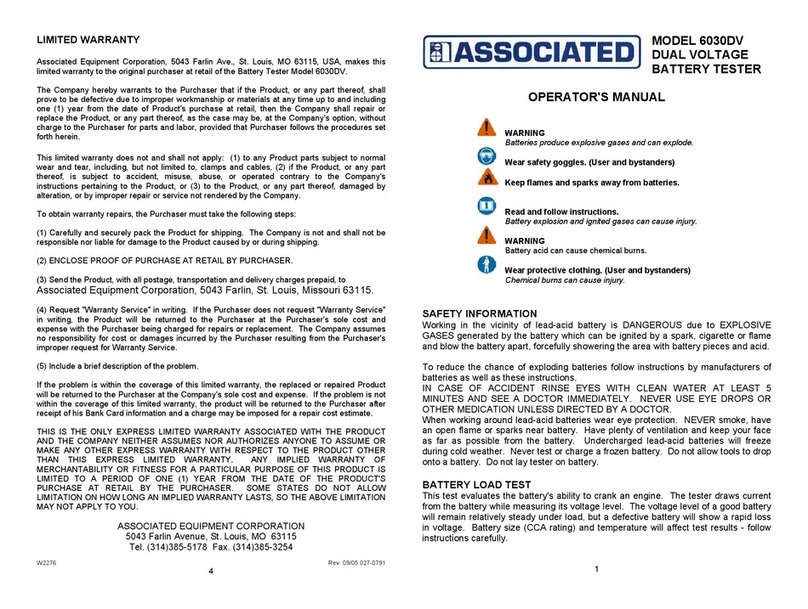
5
STARTER TESTS
Current draw of the starter, battery voltage, and voltage drop of
leads can be measured when connected as shown (See figure
8).
This unit is designed to capture the maximum (peak) starting
current , the running starting current and the minimum battery
voltage when the vehicle is started.
Review the Safety section in the front of this manual.
1) Attach the heavy duty leads to the battery as shown.
2) Press Test Selection [2] button until the starter LED is lit.
3) Press Start Test [4] button Starter LED will start to flash.
Attach the Amp Probe around the lead from the positive
battery terminal to the starter. If that cable is not
accessible, it may be placed around the ground cable that
runs from the frame or engine block to the negative battery
terminal.
4) Be sure that all the lights and accessories are turned off.
3) Start the engine. Under no condition should you crank
more than 10 seconds at a time. The tester will alternate
the amps display showing the maximum cranking current
with the “MAX. AMPs” LED lit and the
starter running
current
at this time in the amps display. It will also display
the minimum battery voltage with the “MIN. VOLTS” LED lit
alternating with the actual battery voltage in the voltage
display.
4) Minimum acceptable voltage for most vehicles while
cranking is 9.6 volts. Typical
starter running currents
(this would be the smaller current displayed) for vehicles
are:
4 cylinder gas engine--up to 175 amps
6 cylinder gas engine--up to 225 amps
8 cylinder gas engine--up to 250 amps
8 cylinder diesel engine--up to 650 amps
The vehicle service manual should be consulted for more
detailed information. While the vehicle is starting, you should
listen for high pitch or low growling sounds that may indicate
bearing or other problems.
Connections between the battery and starter and between the
battery and frame can also be checked at this time.
STARTER
MOTOR
STARTER
SOLENOID
FRAME
FRAME
+ -
BLACK
LEAD
RED
LEAD
1
2
3
4
5
6
Excessive voltage drop in either cable caused by loose or corroded
connections, undersized, or broken wires may be the problem, not
the starter.
Testing procedure using the Eternal Voltage leads: Review safety
section in the front of the manual. (see figure 8)
1) Attach tester to battery as shown. Press Test Selection [2]
button until the Starter LED is lit: press Start Test [4] button.
2) Attach positive external lead to positive battery terminal (1).
Attach negative (light gauge) external lead to starter solenoid
where the lead from the battery terminates (2).
3) Start the vehicle, press the up arrow this will display the
maximum differential (external) voltage reading during the
starter test.
4) Repeat the same procedure, checking the voltage drop across
the solenoid, (negative lead to starter side of solenoid), (2 to 3).
5) Repeat again, checking the voltage drop between the solenoid
and the starter. (Positive lead at solenoid, negative lead at
starter.) (3 & 4).
6) Repeat again, checking the ground cable from the battery to the
engine block. (Positive lead to engine block, negative lead to
battery negative terminal.) (5 & 6).
7) Acceptable voltage drop on any wire lead should be 0.2 volts or
less. Voltage drop across the starter solenoid should 0.3 volts
or less. Check vehicle service manual for further details.
CHARGING SYSTEM TESTS
Please review all the safety instructions in the front of this
manual before running these tests.
Charging problems can be caused by a number of different
things. These can include loose belts, defective diodes or
stators, defective regulators, corroded or loose connections or
defective diode trios (GM cars).
Undercharging will shorten battery life and may not provide the
proper charge to start the vehicle. Overcharging will cause
excess water usage in the battery and shorten battery life.
Proper charging voltage and current from the charging system
to the battery is important for the longest life and maximum
performance.
The proper end of charge voltage will depend on the type of
battery installed by the manufacturer and ambient temperature
of the charging system.
●
A conventional battery (lead-antimony ) will require
charging voltages up to about 14.5 volts.
●
A recombination battery or low maintenance battery may
require charging voltages up to about 14.8 volts.
Voltage specifications will vary from manufacturer to
manufacturer. The service manual for the vehicle should be
consulted for exact charging specifications.
TO
ACCESSORIES
FRAME
+ -
BLACK
LEAD
RED
LEAD
ALTERNATOR
FRAME
It is also important that the charging system be capable of putting out
it's rated current. If the electrical load, (lights, blower, power
accessories, etc.) in the vehicle is more than the output of the
alternator, the battery will discharge to provide the needed current.
The battery may become discharged and will not recharge until some
of the load is turned off. This type of discharge/charge cycle will
greatly shorten the life of the battery. Therefore, output current as
well as output voltage of the charging system should be checked.
NOTE:
A check of the charging system should include a check of the
battery cables to ground and to the alternator to determine bad
connections.




























